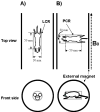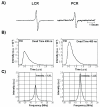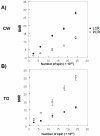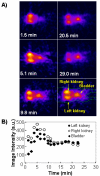Evaluation of sub-microsecond recovery resonators for in vivo electron paramagnetic resonance imaging
- PMID: 18042414
- PMCID: PMC2258207
- DOI: 10.1016/j.jmr.2007.11.004
Evaluation of sub-microsecond recovery resonators for in vivo electron paramagnetic resonance imaging
Abstract
Time-domain (TD) electron paramagnetic resonance (EPR) imaging at 300MHz for in vivo applications requires resonators with recovery times less than 1 micros after pulsed excitation to reliably capture the rapidly decaying free induction decay (FID). In this study, we tested the suitability of the Litz foil coil resonator (LCR), commonly used in MRI, for in vivo EPR/EPRI applications in the TD mode and compared with parallel coil resonator (PCR). In TD mode, the sensitivity of LCR was lower than that of the PCR. However, in continuous wave (CW) mode, the LCR showed better sensitivity. The RF homogeneity was similar in both the resonators. The axis of the RF magnetic field is transverse to the cylindrical axis of the LCR, making the resonator and the magnet co-axial. Therefore, the loading of animals, and placing of the anesthesia nose cone and temperature monitors was more convenient in the LCR compared to the PCR whose axis is perpendicular to the magnet axis.
Figures






References
-
- Yasukawa K, Kasazaki K, Hyodo F, Utsumi H. Non-invasive analysis of reactive oxygen species generated in rats with water immersion restraint-induced gastric lesions using in vivo electron spin resonance spectroscopy. Free Radic Res. 2004;38:147–55. - PubMed
-
- Mikuni T, He G, Petryakov S, Fallouh MM, Deng Y, Ishihara R, Kuppusamy P, Tatsuta M, Zweier JL. In vivo detection of gastric cancer in rats by electron paramagnetic resonance imaging. Cancer Res. 2004;64:6495–502. - PubMed
-
- Yamato M, Egashira T, Utsumi H. Application of in vivo ESR spectroscopy to measurement of cerebrovascular ROS generation in stroke. Free Radic Biol Med. 2003;35:1619–31. - PubMed
-
- Matsumoto K, Subramanian S, Devasahayam N, Aravalluvan T, Murugesan R, Cook JA, Mitchell JB, Krishna MC. Electron paramagnetic resonance imaging of tumor hypoxia: enhanced spatial and temporal resolution for in vivo pO2 determination. Magn Reson Med. 2006;55:1157–63. - PubMed
-
- Mailer C, Sundramoorthy SV, Pelizzari CA, Halpern HJ. Spin echo spectroscopic electron paramagnetic resonance imaging. Magn Reson Med. 2006;55:904–12. - PubMed
Publication types
MeSH terms
Substances
Grants and funding
LinkOut - more resources
Full Text Sources

